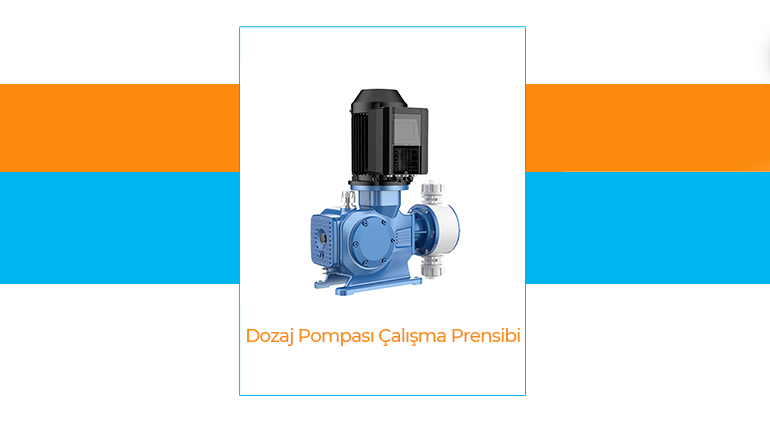- sisdoz@sisdoz.com.tr
- TR
Blog
- Home
- Sisdoz Blog
- Dosing Pump Working Principle

Dosing pumps are critical equipment used for mixing and transferring liquid chemicals, solutions or other fluids at certain rates at points requiring precision in industrial processes. Used in many sectors such as chemistry, medicine, environmental technologies, food, beverages, and petrochemistry, these pumps ensure that liquids are dosed in the correct amount and in a controlled manner. So how do dosing pumps work? In this article, we will examine the working principle, areas of use and types of dosing pumps in detail.
What is a Dosing Pump?
A dosing pump is a type of pump that allows the transfer of a certain fluid in the correct amount for a certain period of time. These pumps are generally used in processes that require precise dosing of chemical substances. The main purpose of dosing pumps is to ensure the precise flow of liquids under pressure. In this way, the desired chemical or liquid substance is included in the mixture at a certain rate and this process can be repeated continuously with the same precision.
Dosing Pump Working Principle
The working principle of dosing pumps is basically based on three stages: suction, pressurization and discharge. These stages ensure that the liquid is transferred correctly thanks to various mechanical parts inside the pump.
1. Suction Stage The first stage of the dosing pump is the drawing of the liquid into the pump. This stage is carried out with the help of the suction valve. The pump creates negative pressure during operation during the suction stage and draws the liquid from the source into the pump's chamber. The piston or diaphragm inside the pump moves and creates a vacuum effect, and this vacuum effect allows the liquid to enter the pump.
2. Compression Stage The liquid accumulates in the pump's chamber after the suction stage. At this point, the liquid is compressed by the backward movement of the pump piston or diaphragm. The liquid that remains under pressure is ready to be directed out of the system. This stage is extremely important for controlling the desired dosage amount in the pump. The precise control systems of the dosing pumps regulate the liquid flow during this pressurization phase, and various electronic and mechanical parts are used to adjust the desired dosage amount.
3. Discharge Phase The pressurized liquid is pumped out of the system through the discharge valve. This liquid is integrated into the system to be transferred in specified amounts. The precise structure of the dosing pumps ensures that the liquid is discharged into the system in the correct amount and at the correct pressure. In order to avoid any leakage or pressure loss during this phase, it is of great importance that the discharge valve and the pump chamber work properly.
Types of Dosing Pumps
Dosing pumps are divided into various types as they are used in different sectors and applications. The most common types of dosing pumps, which are classified according to different working principles and purposes, are as follows:
1. Diaphragm Dosing Pumps Diaphragm dosing pumps are widely used in applications requiring chemical resistance. These pumps pump the liquid with the back and forth movement of a diaphragm. Since the diaphragm prevents the liquid from coming into contact with the pump, it is extremely effective in transporting abrasive or corrosive substances. They are often preferred in chemical processes. There is no risk of leakage in any way.
2. Piston Dosing Pumps Piston (Plunger) dosing pumps are used for applications requiring higher pressure and more viscous fluids. These types of pumps pump the liquid with the back and forth movement of the piston. Piston pumps work efficiently, especially in high-pressure systems, and are capable of precise dosing. They are widely used in industrial chemistry and petrochemical sectors.
3. Peristaltic Dosing Pumps Peristaltic dosing pumps transport liquid through a flexible hose or pipe. These pumps work on the principle of pushing the liquid forward by squeezing it from the outside of the hose. Since the liquid inside the hose does not come into contact with any mechanical parts, it is preferred in sterile and sensitive applications. They are especially used in the food, pharmaceutical and biotechnology sectors.
Areas of Use of Dosing Pumps
Dosing pumps are widely used in many sectors. The most common areas of use are: Chemical Sector: Used for the precise and safe transportation of chemical substances.
Environmental Technologies: Used in environmental processes such as wastewater treatment, disinfection and pH balance.
Food and Beverage Sector: Preferred in the dosing and mixing of sensitive liquids.
Pharmaceutical Sector: Provides the desired mixing ratios by performing sterile and precise dosing in pharmaceutical production processes.
Petrochemical Sector: Used in chemical processes, processing of petroleum derivatives and dosing of other industrial chemicals.
Advantages of Dosing Pumps
The main advantages obtained in the use of dosing pumps are as follows:
Precise Control: Dosing pumps ensure that the liquid is transferred in the specified amount and precisely.
Reliability: Dosing pumps manufactured from chemically resistant materials offer safe use in difficult conditions.
Flexibility: Can be adjusted in a wide range for different liquids. Can be used in many areas from chemical dosing to water treatment.
Low Maintenance Cost: Thanks to their durable structures, they operate smoothly for a long time and their maintenance costs are low.
Dosing pumps are critical equipment that increases the efficiency and accuracy of industrial processes. Ideal for precise liquid dosing and mixing processes, these pumps have a wide range of uses in different sectors. It is important to understand the working principle of the pump for the correct operation and effective use of dosing pumps. With regular maintenance and correct adjustments, the life of dosing pumps can be extended and system performance can be increased.

